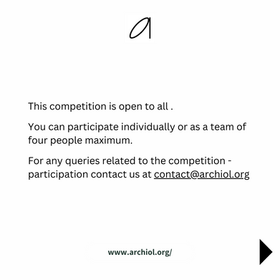Competition Introduction
Introduction
The Experiential Architecture Design Competition challenges participants to create an innovative and immersive architectural design that provides a unique and sensorial experience of blindness for all visitors. The goal is to design an experiential design that allows sighted individuals to perceive and understand the world through the perspective of blindness, fostering empathy, awareness, and a deeper appreciation for the human experience.
Design Requirements:
1. Sensory Engagement: Design an environment that stimulates the senses, excluding the sense of sight. Incorporate elements that engage touch, sound, smell, and taste to create a rich and immersive experience. Explore textures, materials, soundscapes, scents, and flavors that evoke emotions and provoke introspection.
2. Spatial Configuration: Create a spatial layout that encourages exploration and interaction. Provide pathways and zones that allow visitors to navigate the museum independently, relying on senses other than sight. Consider the flow of movement, accessibility, and intuitive wayfinding to ensure a seamless experience.
3. Simulation of Visual Impairment: Design areas or exhibits that simulate the challenges faced by individuals with visual impairments. This may include using blindfolds, obscured lighting, or other techniques that temporarily restrict sighted visitors' vision. The aim is to offer an empathetic understanding of the everyday obstacles faced by visually impaired individuals.
4. Tactile and Auditory Installations: Incorporate interactive installations that encourage tactile exploration and auditory engagement. Design exhibits that allow visitors to touch and feel objects, textures, and surfaces, while providing audio descriptions or ambient sounds to enhance the experience.
5. Multi-sensory Wayfinding: Develop non-visual wayfinding strategies to guide visitors through the museum. Utilize tactile maps, audio cues, braille signage, and other sensory elements to assist with navigation. Ensure that the museum is inclusive and accessible to all visitors, regardless of their visual ability.
6. Adaptive Technologies: Integrate adaptive technologies and assistive devices that enhance the experience for both visually impaired and sighted visitors. This may include audio guides, augmented reality, haptic feedback, or other innovative solutions that provide additional layers of information and engagement.
7. Inclusive Spaces: Design spaces that accommodate diverse needs and abilities. Provide quiet areas for reflection, accessible seating, and restrooms, as well as areas for guide dogs. Consider the comfort, safety, and privacy of all visitors throughout the museum.
8. Environmental Considerations: Incorporate sustainable and eco-friendly design principles throughout the museum. Utilize natural lighting, energy-efficient systems, and environmentally conscious materials, while ensuring they do not compromise the overall experience.
Participation:
• This competition is open to all.
• You can participate individually or as a team (Maximum 4 members in a team)
Prizes & Recognition
Recognition is the key to success for any design professional. Archiol is providing an opportunity to showcase your creativity at the global level. This opportunity is open to all.
TOP 3
CERTIFICATE OF ACHIEVEMENT
INTERVIEW
(TEXT + VIDEO)
PUBLICATION OF AN ARTICLE
/ DESIGN ON ARCHIOL.
ARCHIOL INTERNAL JURY FAVOURITE
PUBLICATION
CERTIFICATE OF ACHIEVEMENT
+3 HONOURABLE MENTIONS
+10 SHORTLISTED ENTRIES
Music files
Select and download a music piece from below:
Jury
We collaborate with leading architects, designers, and academicians of international repute to participate as jury members in our competitions. Contacting any of the jury members leads to disqualification from the competition. Communication regarding the competition should be carried out with archiol staff only. For any queries please contact us at contact@archiol.org
Timeline
Registration Deadline
Tuesday, 31 October 2023
Submission Deadline
Thursday, 2 November 2023
Result Announcement
Friday, 22 December 2023
All deadlines are 11:59 PM UTC (Coordinated Universal Time)
Registration Fees Details
ADVANCED REGISTRATION
AR 01: Jul 1st – Jul 16th - $25 / ₹500
AR 02: Jul 17th – Jul 26th - $27 / ₹800
AR 03: Jul 27th – Aug 6th - $32 / ₹900
STANDARD REGISTRATION
SR01: Aug 7th – Aug 21st - $37 / ₹1000
SR 02: Aug 22nd – Sept 6th - $39 / ₹1500
SR 03: Sept 7th – Sept 21st - $42 / ₹2000
LATE REGISTRATION
LR01: Sept 22nd – Sept 30th - $57 / ₹2600
LR02: October 1st – October 15th - $59 / ₹2610
LR03: October 15th – October 31st - $60 / ₹2620
UNIVERSITY DISCOUNTS
Contact us to receive university discounts. Send us a request from your university email address along with basic information about yourself and your university/school. Attach your university ID cards to the email.
-
Architecture Students group
-
min. 5 participants from the same institution: 10% off on standard & late registration fee.
-
min. 15 participants from the same institution: 20% off on standard & late registration fee.
-
DISCOUNT FOR INDIAN PARTICIPANTS
10% off on standard & late registration fee.
Results!
FAQ
Competition Organizers










.jpg)











